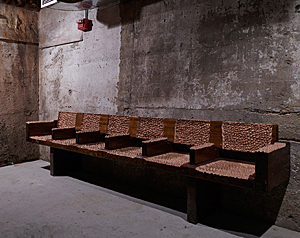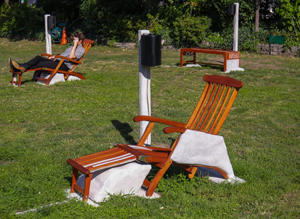A Sanctuary in Winter
John Haberin New York City
Hugh Hayden and the Socrates Annual
Amid the debate over whether to keep schools open in a pandemic, somehow no one has thought to ask: why not hold classes outdoors? After all, outdoor seating works for restaurants, and eating out is supposed to be fun. So why not school?
Hugh Hayden dares New York to give it a try. He sets out neat rows of school desks in Madison Square Park—a good hundred of them, as Brier Patch. Surrounding trees darken the sky above their plain blond wood, but they have a dark ending of their own. Twisting branches rise up from each one. They may not accommodate students, but they raise disturbing questions for how and how well students learn,  especially students in the city's public schools. They also ask where art and nature begin and end.
especially students in the city's public schools. They also ask where art and nature begin and end.
All I wanted was to get into heaven. For a believer, that does not seem too much to ask, but no matter if it never works out. You can always have New York's city parks. Gi (Ginny) Huo may plead for more, but she made it into Socrates Sculpture Park on a glorious fall day—and so did her work with that plea inscribed on one side. "Sanctuary," this year's Socrates Annual, celebrates the park as a refuge and, yes, sacred ground. But then where would public spaces like this be if they could not embrace both the sacred and profane?
Live and learn
Joking aside, why has no one asked for what Hugh Hayden delivers? In real life, schools, unlike parks, cannot count on outdoor real estate, and they can sure count on brutal New York winters. The work opened on a January day, when temperatures refused to break freezing, and his bare branches looked all too close to those of the park itself. It could not hold much comfort for parents eager for classes or for teachers fearful for their health and safety, but then Hayden does not traffic in comfort—not even when the Met enlists him in response to Winslow Homer. He stood out among the emerging artists in last year's edition of "In Practice" at SculptureCenter, for a subway-station bench covered with spikes. There, too, he presented generic seating for the masses with spiky implications.
For all that, some might take the idea seriously, just not for city schools. Nature as a teacher has a long history. For admirers, it stands in the face of corrupt institutions like, oh, civilization. Even now, some suburban private schools take outdoor classes as their mission and advertise it as, well, only natural. I have no idea how many show up. Hayden, for one, would be skeptical of nature's promises.
One can imagine nature as having overrun its promises and his craft. The untamed branches rise up from small blond mounds on the tops of desks as if of their own accord. They cluster on four separate lawns of Madison Square Park, like distinct learning centers or a single surge of uncontrolled life. Hayden leaves ample space between desks, but they seem perilously close together, with little room for seating. And yet, for all the show of growth, he makes no pretence whatsoever of having planted the trees in raw earth. Whether Brier Patch will make more or less sense amid April leaves remains to be seen, but it is still very obviously art.
One might think of the work as alive, only to remember that art creates the very signs of life—like trees from Ellen Altfest and Babs Reingold. Whatever happened to the branches lopped off from the park's preceding installation, Ghost Forest by Maya Lin? She set out the trunks of dead trees, in stark contrast to the live ones to all sides. Hayden might well have recycled her lumber for his desks. Her story turned on threats to nature from climate change, while his turns on threats to children and families. Both, though, take the demands of a site-specific installation seriously, building on their neighbors.
Hayden's title refers to the Briar Patch—Br'er Rabbit's home in the stories by Joel Chandler Harris and Walt Disney's 1946 Song of the South. The rascally rabbit manages an escape to higher ground, only to fall right back, as Br'er Fox and Br'er Bear outsmart him yet again. More pressingly in the present, the work alludes to public schools and how badly they serve African Americans. They could use the commitment and resources devoted to city parks like this one. Briers, in either spelling, are never less than thorny. That subway bench is looking more welcoming all the time.
Nature may not offer plain truths, but Hayden's layered meanings may not all work either. Briers are not trees, and what does he really think of Uncle Remus stories? Do they represent for him a cultural heritage or just white racism? Do his desks really have much in common with the state of public education? Still, for all my doubts, there is no escaping his vision of propriety and excess. It points to the tension between natural growth and human communities, hard lessons and the imagination.
Sacred ground
Socrates Sculpture Park sure looked like heaven that fall day, but an earthly one, for an earthly community. Mothers with small children had their circle of blankets, just past what Huo calls An Act or an Offering, What If? One sang gently, accompanied by another on autoharp. A little girl sat atop a 3D print of Bambi by Monsieur Zohore, while the Virgin Mary bent one knee and spread her palms, facing the deer in a humble welcome. Paul Ramírez Jonas is not part of the show, but his Eternal Flame still burns past two successive closing dates now, as a pillared outdoor grill. Heaven can wait.
 A park can offer a refuge, but never a world apart. The closest it comes is a grove of trees, where Rachel Frank erects a ceramic mushroom, topped by a woodcock, oysters, and lichen. She singles them out as bellwethers of climate change, lest many a sanctuary soon be gone. The trees more fully enclose a cheap backyard pool set amid what looks like crumbling bedrock. Monica Torres mimics sinkholes in the Yucatan that people have adopted as sacred sites. She refers to the pool's contents as agua creativa, or creative water.
A park can offer a refuge, but never a world apart. The closest it comes is a grove of trees, where Rachel Frank erects a ceramic mushroom, topped by a woodcock, oysters, and lichen. She singles them out as bellwethers of climate change, lest many a sanctuary soon be gone. The trees more fully enclose a cheap backyard pool set amid what looks like crumbling bedrock. Monica Torres mimics sinkholes in the Yucatan that people have adopted as sacred sites. She refers to the pool's contents as agua creativa, or creative water.
What, though, can the Socrates Annual add to the park itself on any given day? River Whittle uses the Broadway billboard above the park entrance for a panorama of Manhattan, in a stippled blue that recalls a vintage photograph—overlaid with Lenapehoking, the homeland of the Lenape or Delaware people, in blood red, even as the American wing of the Brooklyn Museum offers a map. It is a vivid complement to video by Alan Michelson also in Queens, at MoMA PS1 for "Greater New York." Still, it does not match up with the actual view of the Astoria waterfront, for it centers on World Trade Center 1 downtown. Either art or realty falls short, and who am I to say which one? Could "Sanctuary," too, be a near miss—and could that still be enough?
Inside Huo's arch, the phases of the moon pass overhead, above prints of water and greenery. A ramp to one side and steps to another stand for access, but their plain painted wood can feel a letdown, and they run up against the arch like a brick wall. Zohore's faux alabaster or marble glows from within, but its sweetness and light leans heavily on Walt Disney. A platform of cinder blocks with well-timed gaps by Yvonne Shortt, Jenna Boldebuck, and Kelly Li might house more sacred waters, but it is instead a "hair sanctuary," for African American hair. It is An Act of Civil Disobedience, but just a little too self-affirming. Torches by Levani (or Levan Mindiashvili) burn with the brightness of stainless steel, but I may have to return before I can accept them as the interactive setting for a dance.
What they can bring is a diversity of voices, on top of park-goers. Huo traces the arch's ancestry, believe it or not, to Mormonism and Korean Shamanism. Just across the lawn, Moko Fukuyama dedicates his Shinto shrine to Hell Gate, the Queens railroad crossing—in the shape of fish, without fins but in polka dots, and fallen trees, but with painted scales. Anina Major recreates the bulletproof glass that once protected Angela Davis at Madison Square Garden, when she was definitely speaking out. L. J. Roberts sets out rusted bedsprings that her father would have known, with his handwriting in neon. It is sleeping with clenched fists, dreaming with clenched fists, in Hebrew.
He may not have got much sleep, but the artists can still bring repose—along with the very need for a sanctuary, their anxieties. They can also be open to the uses of a park. Jeffrey Meris is a therapist himself, but he thinks instead of his Saturdays for "self-care" when he calls his rising aluminum pipes Catch a Stick of Fire. They look like nothing so much as a public fountain. Andrea Ray sets out actual lawn chairs, in wood, next to speakers that speak of not sanctuary but confinement during the lockdown. Still, it is her Rest Cure, and it provides real people with sunlight and rest.

Hugh Hayden ran in Madison Square Park through April 24, 2022, "Sanctuary" in Socrates Sculpture Park through March 6.




